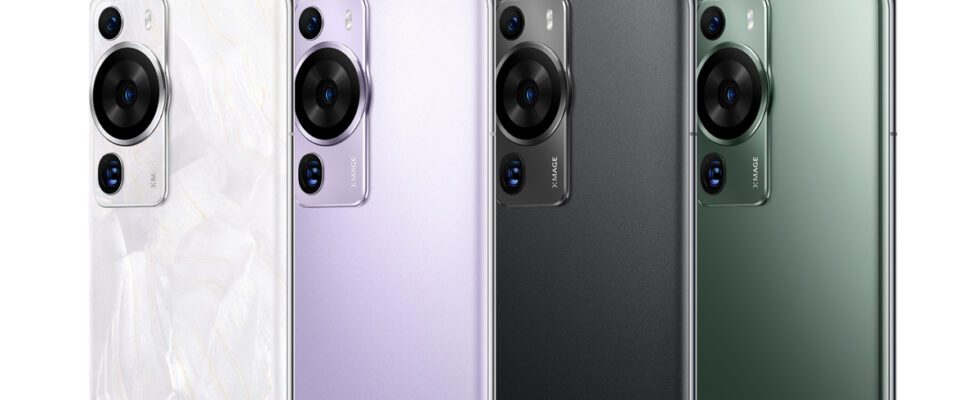Huawei P60 Pro
In the absence of offers discover
The links shown above may not work in the presence of an ad blocker.
Huawei P60
In the absence of offers discover
The links shown above may not work in the presence of an ad blocker.
Customary of the river conferences organized in China, Huawei today formalizes a host of new products, including headphones, computers, watches and smartphones, including its latest flagship series, the P60. Premium terminals oriented, as always, towards photo performance, even in the absence of Leica certification. Huawei’s partnership with the German brand ended last year, and the red dot brand is now collaborating with Xiaomi.
The Huawei P60 Pro © Huawei
The Huawei P60 series is of course led by the P60 Pro, of which Richard Yu, CEO of the brand, had widely praised the photo component upstream. So let’s start with its photo block, with a renewed look, which includes three modules, all equipped with RYYB sensors (and not RGB). The first, with its 48-megapixel sensor, has variable aperture optics, like the Mate 50 Pro launched in 2022 (f / 1.4-f / 4, with ten aperture levels and optical stabilization). The second, of an identical definition, is for its part associated with a periscopic zoom (x3.5, f/2.1, with stabilization), promising a clear progress in terms of photography in low light, poor relation of “zooms ” on smartphones. Finally, a third 13 Mpx sensor is associated with ultra wide-angle optics (f / 2.2); it should be noted that this module is not used to take macro photos, this function being associated with the periscope module.
These photo modules are mounted on a large smartphone, unsurprisingly, which offers a 6.67-inch OLED screen (2700 x 1220 pixels), benefiting from LTPO technology, for a refresh rate varying between 1 and 120 Hz. This slab is not protected by Corning glass, but by its Chinese counterpart Kulun. The device, which measures 161 x 74.5 x 8.38 mm and weighs 200 grams, benefits from IP68 certification, a must in the high-end smartphone segment. Its 256 or 512 GB memory is expandable through a NanoMemory card, Huawei’s proprietary format.
A flagship still deprived of 5G
If it shows the muscles on the photo, display or design side, the P60 Pro suffers from the compromises inherent in the Chinese brand, deprived of 5G chips due to American sanctions. The terminal is thus content with the 4G version of a Qualcomm chip, the Snapdragon 8+ Gen 1, even though the flagships of competing brands now rely on the Snapdragon 8 Gen 2. This platform is flanked by 8 or 12 GB of RAM, and accompanied by a 4815 mAh battery, compatible with 88 W charging (50 W wireless). Let’s add that the chip is, in China at least, compatible with a satellite messaging service (with Beidou) in sending and receiving. A function also expected in future Qualcomm chips…
Huawei P50 Pro

Note Digital

 Amazon Warehouse
Amazon Warehouse607.25
 reBuy
reBuy626.99
 Fnac.com Used Marketplace
Fnac.com Used Marketplace679.90
 Fnac.com marketplace
Fnac.com marketplace760.00
 Amazon Marketplace
Amazon Marketplace781.00
 Darty Marketplace
Darty Marketplace836.99
 Rakuten
Rakuten913.91
 Amazon
Amazon1,044.76
How the pricing table works
Disable your ad blocker to access all the links above.
Huawei Mate 50 Pro

Note Digital

In the absence of offers discover
The links shown above may not work in the presence of an ad blocker.
The smartphone is currently announced only in China under HarmonyOS 3.1; it will probably run, if it is marketed in Europe as the P50 Pro was, under a version of Android supplemented by Huawei Mobile Services. Its price is set at 6988 yuan (8 / 256 GB), or about 940 € excluding taxes, and 7988 yuan (12 / 512 GB), or about 1075 €.
A P60 and a P60 Art to complete the range
The P60 Pro does not in itself embody the new series of smartphones from Huawei. It is for these purposes supported by the P60, which makes very few technical concessions. This terminal is indeed decked out with the same screen, the same chip and the same battery as its big brother, and displays an identical design until its IP68 certification. Its screen is not protected by a Kulun glass, its storage starts at 128 GB, its charge is slightly slower – 66 W wired, but still 50 W wireless –, and its photo block is slightly less sophisticated. The main compromise made by Huawei is thus due to its periscopic module, which is based on a 12 megapixel sensor, associated with a focal length of 125 mm (f / 3.4), i.e. a magnification x5. The prowess announced by the manufacturer in terms of nighttime zoom photography is therefore the prerogative of the P60 Pro.
The Huawei P60 Art has a special design. © Huawei
Let’s finish with the P60 Art, special edition of the smartphone. Identical to the P60 Pro, Kulun glass included, it benefits from a back with more marked curves. This highlights a photo block comprising the same main module and the same telephoto lens as the P60 Pro, but also an ultra-wide-angle module comprising a 40-megapixel sensor. Its battery displays 5100 mAh, and benefits from the 88 W fast charge of the Pro model. Note also that this P60 Art benefits from 512 GB or 1 TB of storage. Options charged at a high price, since the P60 Art is announced at 8988 yuan in 512 GB, or around €1,210 excluding tax, and it costs 10,988 yuan in 1 TB, or around €1,480 excluding tax. The classic P60 is announced between 4488 yuan (about 605 € HT) and 5988 yuan (805 € HT) depending on the storage chosen.
